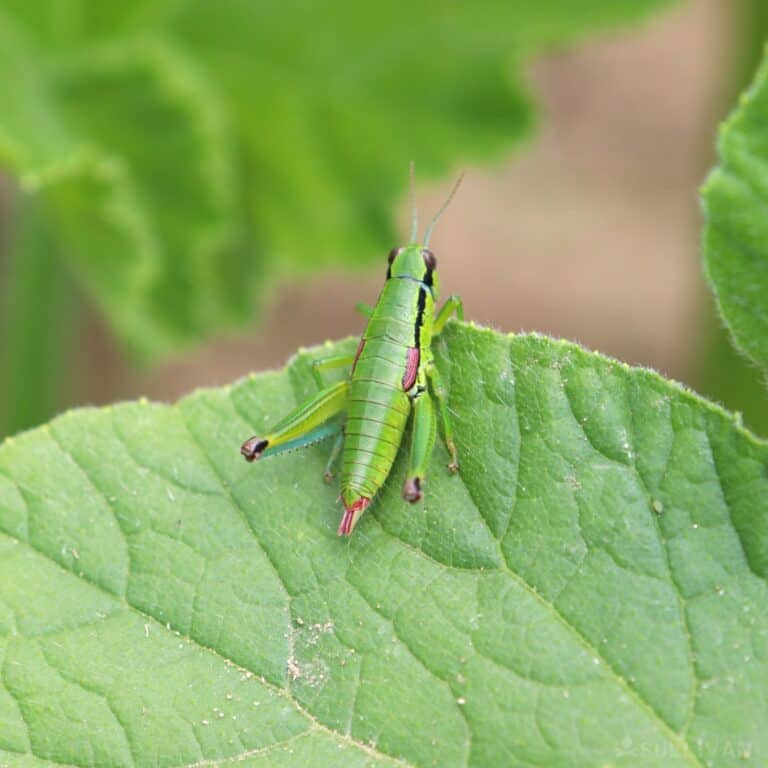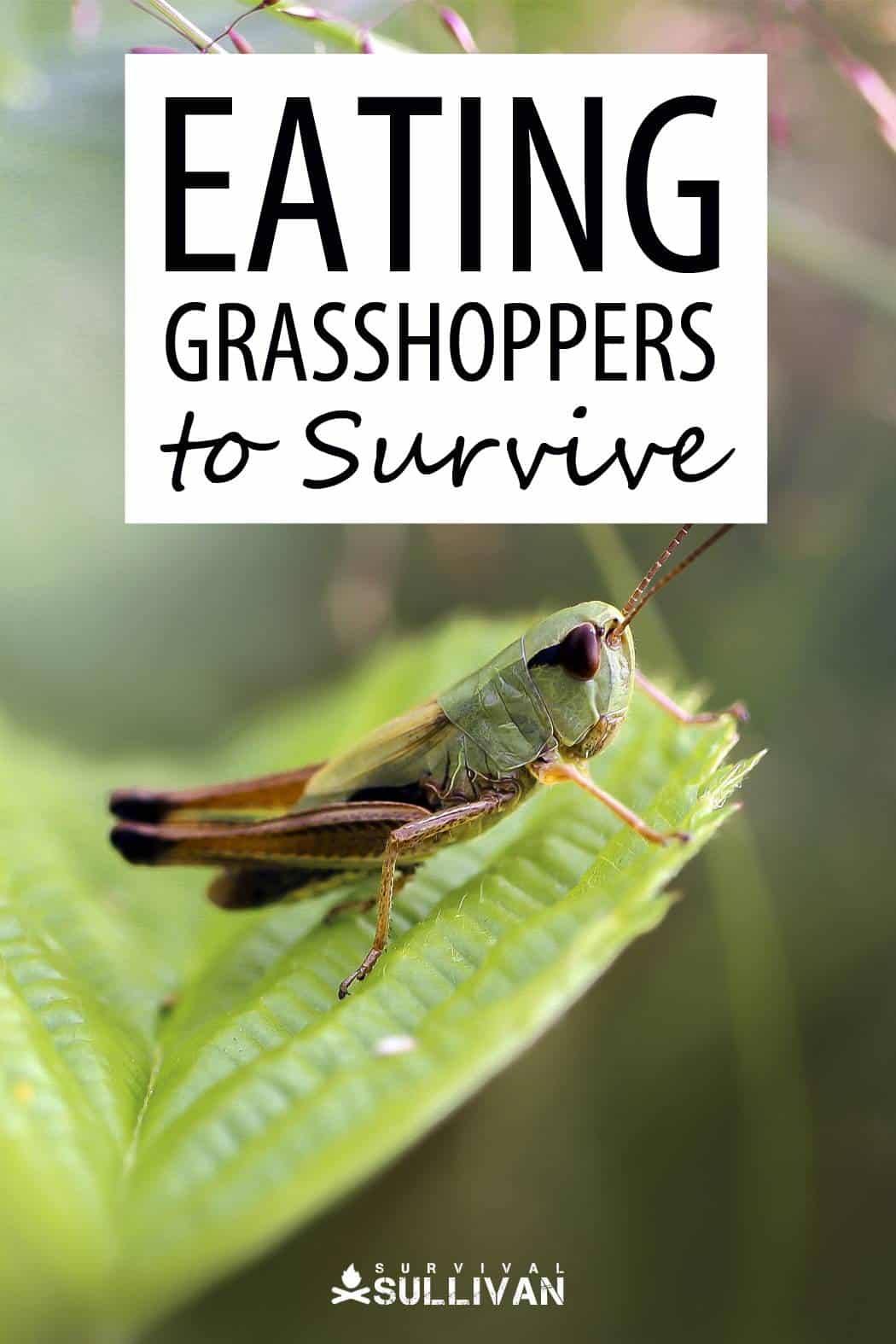The very idea of eating bugs is going to make most people feel queasy from the get-go. And then you go into compound matters by trying to chow down on some of the biggest, beefiest bugs there are, grasshoppers?
Good grief! This is a fairly common stunt on certain shocking TV shows, with segments that show hapless contestants chowing down on crunchy and very much alive insects- including fat, green grasshoppers!

These impressively hefty, jumping, flying insects are ubiquitous across much of America and throughout the world, and they certainly look intimidating at first glance. The million-dollar question is:
Can you survive a food shortage by eating grasshoppers?
Yes, you absolutely can. Grasshoppers represent a substantial source of calories, most of it protein, along with a little fat and carbohydrates. They also have several important minerals, including calcium and iron.
Considering they are so prevalent and fairly easy to catch, you would be well-advised to chow down on grasshoppers whenever you can in a survival situation in order to keep your energy up, or just supplement your food stores.
Now, I am not advising you to run around eating fistfuls of live and kicking grasshoppers. Like so many other things, the devil is in the details and if you are ready to chow down on some ‘hopper, keep reading to learn everything you need to know.
Grasshopper Nutritional Data Examined
Believe it or not, grasshoppers are an extremely common dish or snack in many cultures, and an important source of protein compared to mammals and poultry. In fact, grasshopper meat compares very favorably with beef when it comes to nutrition!
Comparing a 50 gram portion of beef to grasshopper reveals the following: the beef has approximately 13 grams of protein, 7.5 grams of fat, no carbs, 9 milligrams of calcium, and 1.2 milligrams of iron.
How does the grasshopper stack up? The same portion size of ‘hopper’ has 10.5 grams of protein, 3 grams of fat, 2 grams of carbs, a whopping 18 milligrams of calcium, and 2.5 milligrams of iron.
Pretty surprising huh? I know you might have to catch quite a few grasshoppers to total that serving size so, long as you’re willing to work up a little bit of sweat, you shouldn’t have too much trouble: grasshoppers are among the most plentiful insects that you can encounter in a variety of environments.
Be Sure to Cook Them!
Before you ask, yes, you can eat grasshoppers raw, and if you are truly sadistic or just really pressed for calories, you can even eat them alive. However, this is a harrowing experience that I would not wish on my worst enemy.
You can greatly improve the taste and texture of your grasshopper “steaks” by cooking them first, but cooking them does something even more important: It can kill any looking parasites and germs that might be present in the hopper.
Though grasshoppers do not have a reputation as dirty insects or as spreaders of disease, they might still harbor dangerous germs and parasites, both nasty gribblies that can be destroyed by proper cooking seeing as how virtually no germs or parasites can survive high temperatures.
Cooking your meal of grasshopper will provide you with a more pleasant dining experience and also help keep you safe, as the last thing you need in the middle of any survival situation is to contract a debilitating illness which can put you down for the count.
There is not much in the way of a special technique when it’s time to cook your grasshopper, and many regional recipes and methods abound, everything from frying to baking.
In a survival situation though your go-to method is probably going to be roasting or rotisserie over an open fire.
This is easily accomplished by skewering the grasshopper on a sharpened stick or twig, or splitting open a stick to form a sort of clamp or holder for multiple grasshoppers.
When it is time to cook do not get your grasshoppers too close to the flames as they will burn and take on a nasty, charcoal taste that is further compounded by the texture of charred chitin.
Hold them a goodly distance over the flames or hot coals and keep them rotating for anywhere from 10 to 15 minutes. Be sure to let them cool as their innards can be extremely hot!
Prepare them Right for Safety
Some people simply stick a whole grasshopper right in the fire, legs, wings, antennae and all. I definitely don’t recommend that for a couple of reasons.
First, just like any other animal, you are going to eat a little preparation of the carcass (or in this case of the live critter!) will go a long way towards improving the taste and mouthfeel.
Second, certain parts of the grasshopper can actually represent a fairly substantial choking hazard, or at the very least get aggravatingly caught on the soft tissues of your mouth.
You don’t want to make this any grosser than it already is, and you definitely don’t want to die from choking on a grasshopper bit, so what should you do? Simple, I recommend removing the grasshopper’s wings, wing covers and legs.
The reasoning is simple: none of these provide very much in the way of nutrition, but all of them will degrade the taste and texture of the grasshopper, while also posing a substantial choking hazard, especially the legs.
If you take the time to examine a grasshopper’s legs, particularly its rearmost set of legs that it uses for jumping, you will note they are stocky, powerfully-built and covered in fine, thin spines.
These spines are more than capable of catching, scratching and becoming caught in the tissues of your mouth, and you definitely don’t want that to happen, especially when swallowing.
Chances are you will not be so crazily desperate for calories that you will need to eat every last morsel of the grasshopper, including the less than choice bits, as where you find one you will likely find many more!
How Else Can You Eat The Grasshoppers?
Aside from the texture, the taste of grasshoppers can be something less than desired. This quest to make insects more palpable has led to some crazy innovations in the culinary world. Grasshoppers and crickets are getting dried and ground up into a flour substitute.
Eating Grasshoppers Raw
The taste of a raw grasshopper can be similar to a prawn or crayfish. In a survival situation the satisfying crunch can provide some morale as many cooked wild edibles can be mushy or slimy.
However, it is strongly advised that you do not eat raw grasshoppers since they can carry toxic bacteria inside.
Think of it like drinking sea water: you want to quench your thirst but the salt content will dehydrate you ,pre. It’s just not worth the risk to your health, especially in a survival situation.
Beware Toxic Grasshoppers
Certain grasshopper species, like Aularches miliaris also known as the coffee locust, a native to South Central Asia, are toxic, and should not be eaten.
As with other insects, generally speaking, you want to stick to grasshoppers that are some varying shade of brown, tan, black or green.
Iridescent colors, yellow, orange and red are warning indicators in nature that the creature in question may have a venomous defense mechanism or is merely toxic to eat.
This is not always the case, as certain colorations are bluffs intended to ward off potential predators; the insect in question might not be poisonous at all. But that being said, such a discussion and classification is beyond the bounds of this article.
You’ll have to learn about and identify the grasshopper species in your region on your own, particularly which ones are not suitable for eating.
Frequently Asked Questions
Yes, you can get bitten by a grasshopper. While they don’t actively bite people they do have mouths that are capable of chomping down on your hand.
Absolutely! Farming grasshoppers in Mexico and Africa is common practice today. A lot of the world’s stock of grasshoppers will be farmed out from these countries.
Eating grasshoppers is safe as long as they are cooked. You can boil them in water or roast them over a fire. Raw grasshoppers are not considered safe to eat.
Conclusion
Grasshoppers are absolutely edible, and should be eaten as choice fare in a survival situation. They provide ample nutrition in the form of protein, fats and minerals, are easy to catch and plentiful.
As far as insects go, you can rarely do better than some juicy, roasted grasshoppers. Make sure you take the time to remove the hazardous parts of their anatomy and cook them if at all possible.
So long as you follow these simple guidelines, you will rarely go wrong with grasshoppers.


Tom Marlowe practically grew up with a gun in his hand, and has held all kinds of jobs in the gun industry: range safety, sales, instruction and consulting, Tom has the experience to help civilian shooters figure out what will work best for them.
